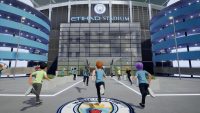CES: Canon and Sony Tools Provide a Virtual Take on Sports
January 7, 2023
At CES this year, Canon and Sony both showcased multi-camera capture technologies with an eye towards attracting a younger generation of viewers. Canon’s Free Viewpoint video system (using an AI-powered ring of high-resolution cameras in a stadium or arena) and Sony’s combined tools from its Hawk-Eye vision processing company and recently-acquired AI-based data visualization firm Beyond Sports can create low-latency virtual reproductions of live sports. The capture from multiple angles enables the virtual reproduction to offer interaction that a simple video stream does not, though each technology is distinct in what it offers.
At the show, Canon’s Free Viewpoint technology was branded as more of a virtual production solution, used in the creation of a volumetric scene for director M. Night Shyamalan. Overall, however, the company is more focused on sports applications for the system.

The data emerging from these rig systems isn’t high-fidelity, but can provide a clean enough volumetric model with a 3-second delay from capture to stream. Currently, the technology is being piloted in the NBA, used by the Brooklyn Nets and Cleveland Cavaliers for instant replays on regional streams or social media posts.
While Free Viewpoint offers the advantage of volumetric capture, Sony’s Hawk-Eye is probably more commonly recognized for its sports capture tools. Hawk-Eye offers a 29-point ball and skeletal tracking system, which it is then able to translate into virtual reproductions.

Working with their sister company, Beyond Sports, Hawk-Eye recently released Gameface, an app with interactive versions of these reproductions.
Targeted towards a Gen Z audience, Gameface uses Roblox-esque block characters as virtual player stand-ins. Users can set the game within an environment of their choice and re-skin player uniforms as they desire. They can also choose one of a number of defined views from which to watch the game, and zoom in to catch specific details. (The possible views are determined by the specifics of the Hawk-Eye rig at the stadiums the game took place in.)

Hawk-Eye also recently launched a more built-out version of a virtual integration with Manchester City’s Premier League team, building a metaverse world where fans can meet each other and interact with 3D recreations of previous games. Although the latency for converting live positional tracking to a virtual recreation is low (under 0.5 seconds according to the company), the Manchester City game recreations currently aren’t available in the virtual world until a day after they are played.

While there are subtle distinctions between what each technology can offer, they both share a challenge with making the technology an addition worth paying for. Free Viewpoint could support a targeted build-out of the virtual stadium tickets that saw popularity during the pandemic. An experience that offers unique positional views would provide product differentiation between ticket options, although it does raise the question of whether that is a feature of physical reality that should be replicated virtually.
In general, virtual reproductions, especially those derived solely from positional tracking, lose out on a key feature of what makes watching matches fun: the ability to see the expressions of players on the field. Losing that key feature — especially for dedicated fans that follow players and not just the game — can’t be compensated for with a broader range of angles to view the action from.
Beyond Sports attempts to get around this problem by abstracting out the data to virtual avatars that bear no resemblance to the players and positioning the experience as a gamified one. But for those who aren’t already a fan of the sport, seeing the same game — even with viewpoint control and youth-friendly visuals — might not make the experience more engaging.

No Comments Yet
You can be the first to comment!
Leave a comment
You must be logged in to post a comment.